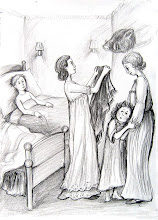Briggs, Julia. Virginia Woolf: An Inner Life. Harcourt, 2005.
According to Julia Briggs in Virginia Woolf: An Inner Life, the character of the woman artist in To The Lighthouse was originally called Sophie Briscoe, and was described as “a kindly, rosy lady with a taste for hedgerows and cottages.” (166) Very soon, though, Woolf had re-created her artist as Lily Briscoe, a woman artist who embodied the characteristics of Woolf herself; modern, dedicated to her art, and driven by her need to paint, just as Woolf was driven by her need to write. Briggs examines the conflict that exists within Lily, between remaining faithful to her artistic nature and the societal pressure she feels to conform. Lily actually feels pressured to conform on two fronts. She strives to maintain her artistic vision, which differs radically from the popular style of the day, and she grapples with the societal expectations that a woman should be willing to give herself up to love and marriage. With respect to Lily’s artistic vision, Briggs observes, “Her art is at once agony and ecstasy, a rich inner resource and a refuge from social discomfort. She finds the act of painting all-absorbing, and the need to be true to her vision overrides any concern for its future survival.” (180) When Lily’s thoughts turn to love and marriage, Briggs notes that the contradictions in Lily’s mind mirror those of Woolf’s, “Lily Briscoe, like her author, rejects Mrs. Ramsay’s gospel of love and marriage, yet at the same time she could recognize its appeal, could ‘feel violently two opposite things at the same time…It is so beautiful, so exciting, this love…also it is the stupidest, the most barbaric of human passions’.” (172) Briggs points out that To The Lighthouse was an extremely personal book for Woolf, perhaps more so that any other of her works. Briggs writes, “Never had she put so much of herself into her writing. Not only had she re-created her parents and family life at Talland House, but in Lily Briscoe she drew her fullest portrait of the artist, a self-portrait that revealed how intensely and exclusively she lived out her writing.” (179)
Lily Briscoe embodies many of the most important, and most difficult, elements of Virginia Woolf’s life. Briggs does a very credible job of summarizing these various elements and observing the ways in which Woolf has incorporated them into Lily. Briggs also notes the connection between Lily Briscoe and the writer/character that Woolf will go on to imagine: “Lily is not merely a self-portrait; she is a portrait of the artist as woman, anticipating the portrait of the woman writer who would demand A Room of One’s Own, two years later.” (180) It is no secret that Woolf struggled mightily to balance the various roles of her life with her artistic drive. Woolf frequently seemed to feel that life intruded upon her art, and she despaired of ever finding a satisfactory equilibrium. Rather than creating Lily as an ideal, a woman artist uncompromised by these conflicts, Briggs shows us that Woolf invested Lily with her own efforts to reconcile the contradictions: “But life and art cannot be separated, and Lily recognizes that art feeds upon life, while life, in turn may be ‘susceptible, like a picture, to arrangement & order’.” (172) Many of these thoughts and feelings run through Lily’s mind while she is painting. It is as if the creative juices that allow Lily’s painting to flow also activate some kind of mental flow, as if Lily is an open channel through which a cascade pours. The stream of thoughts and the stream of painting seem to be inextricably linked, influencing and shaping each other interchangeably, just as Woolf’s narrative stream links her characters.
Subscribe to:
Post Comments (Atom)



No comments:
Post a Comment